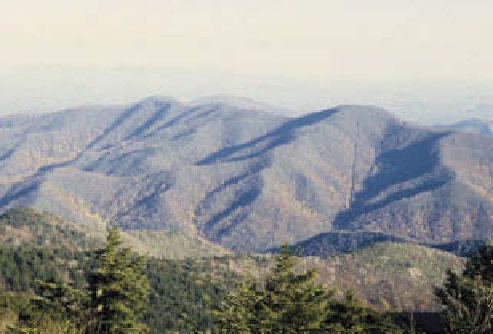Geoscience Reference
In-Depth Information
dating, emplacement depth and degree of exhumation
range between 1-10 km Ma
-1
(orogens) and 0·1-1 km
Ma
-1
(epeirogens). The highest average rates occur in
late Cenozoic and Quaternary orogens, suggesting that
high erosion rates are unsustainable over long periods,
for reasons explained below (compare
Plate 10.4
and
Tectonic evidence also comes from comparing rates of
uplift, the elevation of mountain systems and the
conformity of their summit altitudes. Uplift measured
over short periods at rates of 5-20 mm yr
-1
would raise
another Everest in 1 Ma! This does not happen, owing to
a combination of denudation and changing uplift rates.
They peg Earth's highest summits at 8 km (Himalayas),
7 km (Andes) and 4-6 km (North American cordillera).
Characteristic sawtooth profiles of these and lesser
ranges show a remarkable accordance of summits, broken
only occasionally by 'one that got away'. This suggests
that mountains are steady-state systems where uplift =
denudation, although previous interpretations that they
were dissected from elevated plateaux are experiencing a
revival. After initial orogenic uplift, the denudation of light
continental rocks then triggers further,
isostatic
uplift to
compensate for up to 80 per cent of gross lowering.
Since
net
denudation does occur, denudation and
isostatic compensation must decline over time as the
available relief is progressively lowered.
Figure 13.1
shows
the evolution of a hypothetical orogen uplifted at an
average rate of 1·0 mm yr
-1
for 5 Ma. Denudation reduces
its potential elevation of 5 km to 4 km during that time.
Appalachian ranges, in the vicinity of Mt Mitchell (2,037 m
OD), North Carolina - the highest peak in the United States
east of the Rocky Mountains, beyond Pleistocene ice limits.
Contrast the elevation and subdued form with glaciated
Photo: Ken Addison
Geomorphic systems
SYSTEMS
Geomorphology studies Earth's outermost and therefore contemporary land surface, except where we can distinguish
components of a much older surface exhumed by more recent erosion. The continents are land surfaces 'roughed
out' by longer-term, larger-scale tectonic processes and ornamented by geomorphological processes. In essence,
they transform Earth surface materials and energy from one state or condition to another. They involve rock in any
form (intact, or disaggregated as debris, sediment or soil) and any combination of water, ice, atmospheric gas(es)
and organic matter. Energy may be exogenic (light, heat), endogenic (geothermal heat, gravity), chemical (mineral
bonding, etc.) or combined in the potential and kinetic energy of materials moved by tectonics across Earth's surface.
Denudation interests us for a variety of reasons. Measurements of suspended sediment load in streams, changes
in coastline location, landslide volume or glacial excavation lead us to extrapolate the magnitude of whole-land surface
change and the time scales of events. Armed with a growing database on rates of sea-floor spreading, new magma
formation, uplift, subduction and ocean sedimentation, we are naturally inquisitive about their dynamic balance with
the continents. Knowledge of rates and processes also permits the prediction and management of environmental
change. Some global generalizations set the scene. One measure of the denudation of the whole Earth over its 4·6
Ga life is the extent of reworking given by a planetary evolution index - the ratio of reworked to original planetary
crust. A value of 6·2 for Earth, compared with 0·2 for our moon and 0·7 for Mars, emphasizes the role of endogenetic
and morphotectonic processes in continually recreating Earth's surface. Continental geomorphic systems reflect the
impact and history of those processes. Only 15 per cent of Archaean crust survives today, contemporary mountain
systems belong to three principal orogens less than 500 Ma old and ocean basins are geologically very young.










































